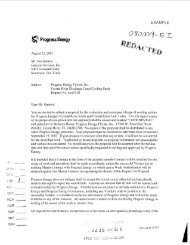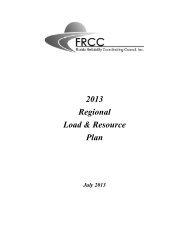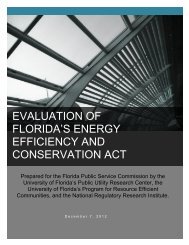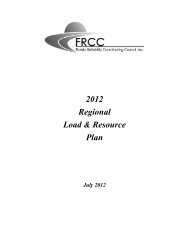Review of 2008 Ten-Year Site Plans - Public Service Commission
Review of 2008 Ten-Year Site Plans - Public Service Commission
Review of 2008 Ten-Year Site Plans - Public Service Commission
Create successful ePaper yourself
Turn your PDF publications into a flip-book with our unique Google optimized e-Paper software.
Transportation<br />
Also contributing to today’s relatively high delivered prices is rail transportation congestion.<br />
As railroads expand tracks to relieve the problem, transportation costs will increase since the railroads<br />
will include returns on expansions in their rates. Some reporting utilities depend entirely on rail for<br />
coal transport. Others use waterborne and rail transportation, both <strong>of</strong> which can reduce costs. Over<br />
the planning horizon, Energy Information Administration (EIA) sees periodic bottlenecks for railroads<br />
transporting western coal to the eastern United States.<br />
Potentially, a combination <strong>of</strong> ocean transport with short-haul rail transport can reduce<br />
delivered MMBtu costs. For utilities with plants at interior sites, the ability to get short-haul rail<br />
transport contracts is an important factor for reducing the costs <strong>of</strong> delivered coal over the planning<br />
period.<br />
Residual and Distillate Oil Price Forecast and Supply<br />
For the planning period, the Organization <strong>of</strong> Petroleum Exporting Countries (OPEC) are<br />
expected to gain market share over non-OPEC countries. By 2012, 7 countries will account for 50<br />
percent <strong>of</strong> world crude oil production. Based on announced exploration and production projects, the<br />
supply <strong>of</strong> oil will increase through 2012.<br />
Oil prices depend on global economic growth, other competing energy developments, and<br />
geopolitics. Economic growth in India, China, and the Pacific Rim countries has increased demand.<br />
Platts, an energy information service, states there will always be a geopolitical risk premium in oil<br />
prices. Current sources <strong>of</strong> geopolitical risk for oil prices are Venezuela, Nigeria, Russia, the former<br />
Soviet states, and the Middle East. New supplies through 2012 may moderate price increases, but as<br />
OPEC gains market share, oil prices are expected to increase at a higher rate. Spare production<br />
capacity for OPEC countries – specifically, Saudi Arabia and the United Arab Emirates – has<br />
decreased, which reduces the ability <strong>of</strong> these countries to increase supply and reduce prices.<br />
Several Florida electric utilities make significant use <strong>of</strong> residual fuel oil (heavy oil) for<br />
generation. The companies provided price forecasts showing nominal delivered prices for residual<br />
fuel oil, typically in three categories based on sulfur content. As noted for petroleum coke, refinery<br />
capacity will increase in the Gulf Coast area and the Caribbean Basin. This expansion will increase<br />
the supply <strong>of</strong> residual fuel oil. For the planning period, the utilities are forecasting stable residual oil<br />
prices.<br />
Florida electric utilities also use distillate oil (No. 2 fuel oil) as a back-up fuel for natural gas<br />
plants that are fuel switchable and as a starter fuel for coal plants. Due to its relatively high price,<br />
utilities do not use distillate oil to generate a significant amount <strong>of</strong> electricity. As with residual oil<br />
prices, the utilities are forecasting stable distillate oil prices.<br />
<strong>Review</strong> <strong>of</strong> <strong>2008</strong> <strong>Ten</strong>-<strong>Year</strong> <strong>Site</strong> <strong>Plans</strong> - 33 -

















